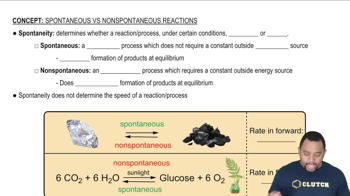Without doing any calculations, determine the signs of ΔSsys and ΔS surr for each chemical reaction. In addition, predict under what temperatures (all temperatures, low temperatures, or high temperatures), if any, the reaction is spontaneous. a. C3H8(g) + 5 O2(g) → 3 CO2(g) + 4 H2O(g) ΔH°rxn = -2044 kJ
Ch.18 - Free Energy and Thermodynamics
Chapter 18, Problem 38
Without doing any calculations, determine the signs of ΔS_sys and ΔS_surr for each chemical reaction. In addition, predict under what temperatures (all temperatures, low temperatures, or high temperatures), if any, the reaction is spontaneous. a. 2 CO(g) + O2(g) → 2 CO2(g) ΔH_rxn° = -566.0 kJ b. 2 NO2(g) → 2 NO(g) + O2(g) ΔH_rxn° = +113.1 kJ c. 2 H2(g) + O2(g) → 2 H2O(g) ΔH_rxn° = -483.6 kJ d. CO2(g) → C(s) + O2(g) ΔH_rxn° = +393.5 kJ
 Verified step by step guidance
Verified step by step guidance1
Key Concepts
Here are the essential concepts you must grasp in order to answer the question correctly.
Entropy (ΔS)
Entropy, denoted as ΔS, is a measure of the disorder or randomness in a system. In chemical reactions, an increase in the number of gas molecules typically leads to a positive ΔS, indicating greater disorder. Conversely, a decrease in gas molecules or a transition to a more ordered state results in a negative ΔS. Understanding the changes in entropy is crucial for predicting the spontaneity of reactions.
Recommended video:
Guided course

Entropy in Thermodynamics
Enthalpy (ΔH) and Spontaneity
Enthalpy, represented as ΔH, reflects the heat content of a system during a reaction. A negative ΔH indicates an exothermic reaction, which generally favors spontaneity, while a positive ΔH suggests an endothermic reaction that may not be spontaneous. The relationship between ΔH and temperature is essential for determining the conditions under which a reaction can occur spontaneously, as described by the Gibbs free energy equation.
Recommended video:
Guided course

Spontaneity of Processes
Gibbs Free Energy (ΔG)
Gibbs free energy, ΔG, combines the effects of enthalpy and entropy to determine the spontaneity of a reaction at constant temperature and pressure. A reaction is spontaneous if ΔG is negative, which can occur when the enthalpy change is favorable (negative ΔH) and/or the entropy change is favorable (positive ΔS). The temperature plays a critical role in this relationship, particularly for reactions with positive ΔH and ΔS, where spontaneity can be temperature-dependent.
Recommended video:
Guided course

Gibbs Free Energy of Reactions
Related Practice
Textbook Question
1
views
Textbook Question
Without doing any calculations, determine the signs of ΔSsys and ΔSsurr for each chemical reaction. In addition, predict under what temperatures (all temperatures, low temperatures, or high temperatures), if any, the reaction is spontaneous. c. 2 N2(g) + O2(g) → 2 N2O(g) ΔH°rxn = +163.2 kJ
Textbook Question
Calculate ΔSsurr at the indicated temperature for each reaction. d. ΔH°rxn = +114 kJ; 77 K
Textbook Question
Given the values of ΔH°rxn, ΔS°rxn, and T, determine ΔSuniv and predict whether or not each reaction is spontaneous. (Assume that all reactants and products are in their standard states.) a. ΔH°rxn = +115 kJ; ΔS°rxn = -263 J/K; T = 298 K
